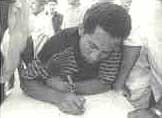Outlining their rights
 MAPS are no longer the exclusive forte of cartographers. Ordinary tribals the world over have begun using mapping techniques to emphasise that they exist. "More indigenous territory has been claimed by maps than by guns. As a corollary, more indigenous territory can be reclaimed and defended by maps than by guns," says Bernard Nietschmann, a professor of geography at the University of California who has also worked with the Miskito people in Nicaragua.
MAPS are no longer the exclusive forte of cartographers. Ordinary tribals the world over have begun using mapping techniques to emphasise that they exist. "More indigenous territory has been claimed by maps than by guns. As a corollary, more indigenous territory can be reclaimed and defended by maps than by guns," says Bernard Nietschmann, a professor of geography at the University of California who has also worked with the Miskito people in Nicaragua.
Indigenous people are rarely recognised by national governments, international organisations or resource harvesting industries. Instead, says Nietschmann, claims are laid on their territories. Intrusions in indigenous territories are backed by making and remaking maps and conditioning people to accept them. Indigenous people are now seeing information as a powerful weapon against outside intrusion. Demarcating their territories themselves is one way of doing this. Many NGOs have sponsored workshops to teach practical mapping techniques to tribals. What is challenging is learning how to put these techniques together in a process that fits each unique landsc4pe, cultural group and land use system and to use them for creating a map that is both scientifically accurate and a correct reflection of local perceptions.
Map-making brings community members together to actively communicate about the land. It is enabling indigenous people to gain recognition of land rights, demarcate and protect traditional territories, gather and guard traditional knowledge, manage lands and resources, mobilise community awareness and resolve conflicts.
Worried about the presence of heavily-armed Honduran lobster pirates and Nicaraguan and us industrial fishing craft that illegally plunder their seas, the Miskitos decided to demonstrate that the territory and its resources were indeed theirs. In 1990, they invited marine geographers and biologists to help them map and inventory the Miskito reefs. In April 1994, the Miskito began the daunting task of mapping the 11,600 sq km area of the reefs. Having successfully prepared a base map, they now plan to use the GPS (Pentagon's 24 navigational satellites for enabling submarines to locate themselves) arid satellite imagery to rectify and redraw the maps, and to establish a network of habitat locations to monitor ecological change.
Similarly, in southern Venezuala, the Ye'kuana people's society was fractured by waves of Catholic and Evangelical missionaries followed by goldminers and tourists. Later, national parks and biospheres were carved out of their lands without consulting them. In 1993, the Ye'kuana resolved to lay claim to their ancestral lands and approached Otro Futuro, a Caracas-based NGO, for technical assistance. Representatives from 15 villages met to finalise a methodology for the demarcation and mapping. The exercise has culminated in a composite and-drawn map of the one million hectares of Ye'kuana territory.
Related Content
- Global trends in climate change litigation: 2023 snapshot
- Prospects for children in the polycrisis: a 2023 global outlook
- What is the right to a healthy environment?
- Leaving no one behind: how a global instrument to end plastic pollution can enable a just transition for the people informally collecting and recovering waste
- World report on the health of refugees and migrants
- Mozambique economic update: getting agricultural support right
